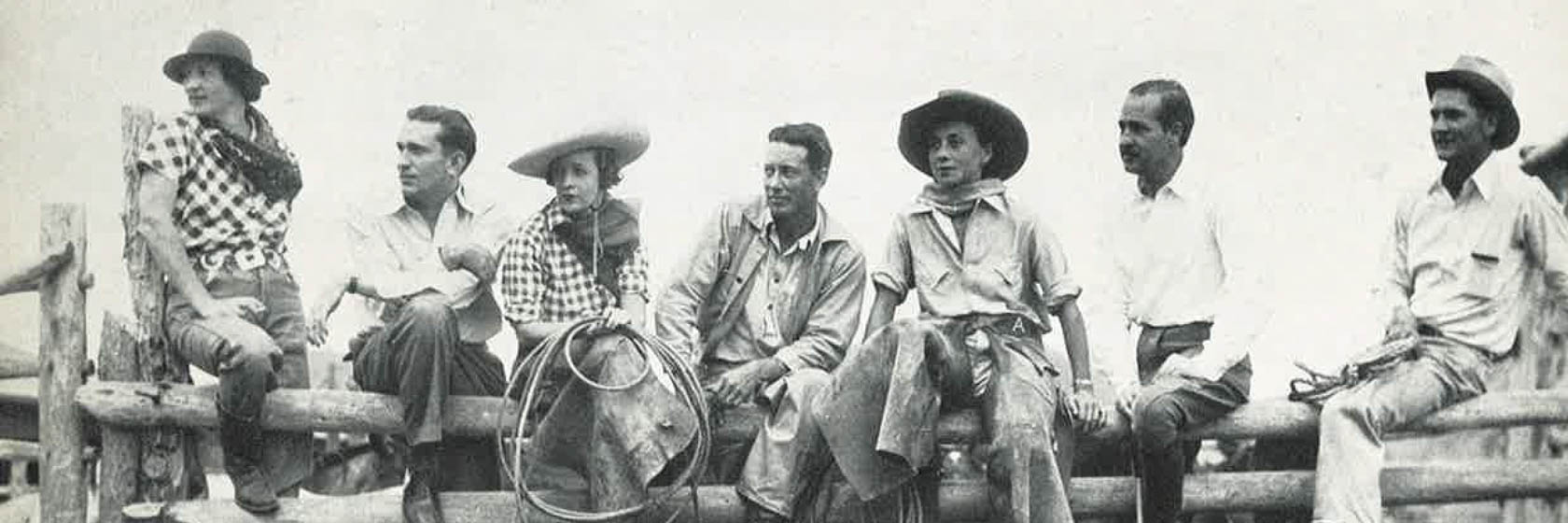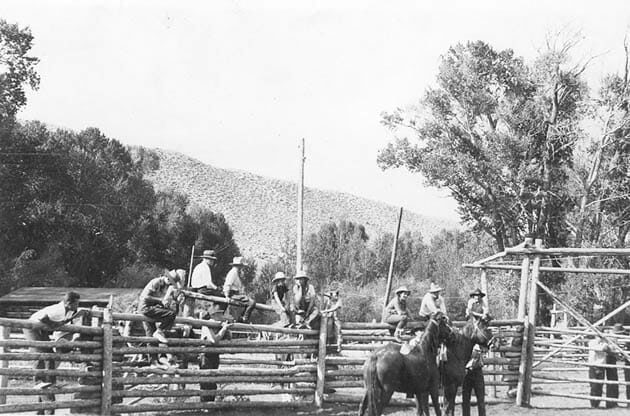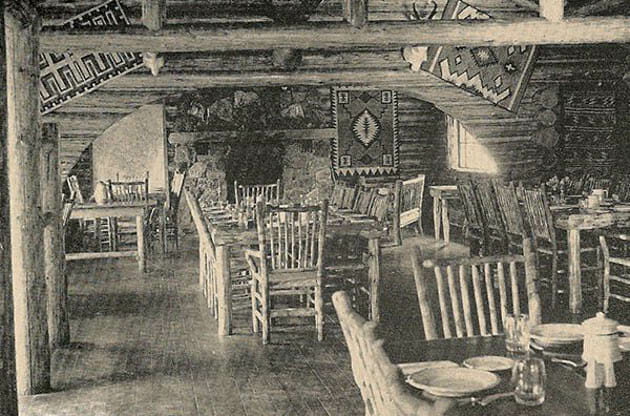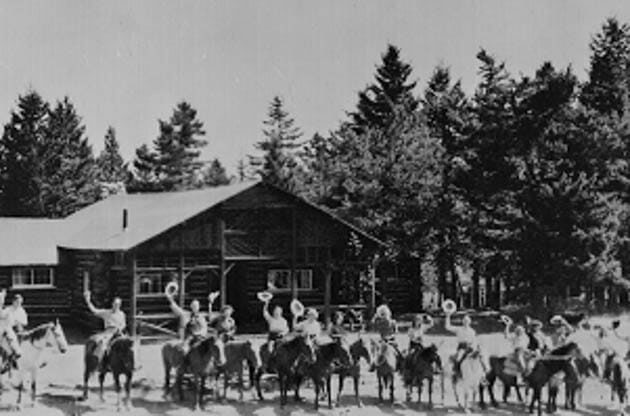
History of the DRA
Dive deep into dude ranch history and learn about how the dude ranch industry and DRA came to be!
The seeds of dude ranch history stretch back to the late 19th century. In the post Civil War cattle boom of the 1880s, Howard Eaton started the Custer Trail Ranch in the Dakota Badlands. He was soon joined by his brothers Alden and Willis and a friend from Pennsylvania, A.C. Huidekoper. Thrilled with their new lifestyle and potential success, the Eatons’ wrote enthusiastic letters to friends back East.

Dude Ranch History Begins in North Dakota
One such letter, published in a New York newspaper, caught the attention of Teddy Roosevelt. Roosevelt quickly made his way out to the Badlands and spent his time hunting, fishing, and riding. He bought the Maltese Cross Ranch near the Custer Trail Ranch and struck up a friendship with the Eatons’ brothers. Stories of ranch life and exceptional hunting spread like wildfire, and soon the Eatons’ found themselves hosting Eastern visitors.
It wasn’t long before their generosity and hospitality led to overwhelming costs. Many visitors recognized the financial burden they were creating and offered to pay for room and board. While the concept flew directly in the face of western hospitality, the Eatons’ had to consider the opportunity. The first recorded paying guest was Bert Rumsey, of Buffalo, NY, and with the purchase of a guest book; the ranch officially began accepting “dudes.”
A devastating wildfire and the unusually harsh winter of 1886 revealed a spring stock count equal to that of their first year on the Custer Trail Ranch. A quick look at the books revealed 2,200 free meals provided in the previous year. The Eatons’ brothers estimated they would have to charge $10 a week for each guest. Capitalizing on the grandeur and serenity that surrounded them, they tailored a unique experience designed to improve the mental and physical condition of their guests, through ranch chores and riding. Before long, the Eatons’ focus on the well-being and enjoyment of their guests became a trademark. Ultimately, their unique style of hospitality became the benchmark for all dude ranches.

Dude Ranch History in Montana & Wyoming
The harsh winter of 1886 and the Panic of 1893 affected ranchers across the country. With the railroad pushing west and cattle prices dropping, Montana ranchers tried their hand at the “guest business.” Many new travelers were anxious to get into Yellowstone and the Big Horn Mountains by horseback. By 1903, as rangeland was fast disappearing in the Badlands, the Eatons’ sold Custer Trail Ranch and moved their operation to Wolf Creek, WY. By 1917, Eatons’ Ranch covered 7,000 acres, ran 500 horses and several hundred head of cattle. Their guest capacity reached 125 – the largest dude ranch in the country.

How Railroads Contributed to Dude Ranch History
As the railroad expanded in the 1920s, dude ranches spread across the west and as far south as Arizona. The cattle industry was struggling and many ranchers were faced with financial hardship. Ernest Miller of Elkhorn Ranch in Montana convinced Max Goodsill of the Northern Pacific Railway that there was an opportunity for a mutually beneficial relationship. Goodsill passed the idea along to A.B. Smith, passenger traffic manager for Northern Pacific who arranged a meeting at the Bozeman Hotel.

Ranch History Is Made
This became the first official meeting of the Dude Ranchers’ Association on September 27th and 28th, 1926. Thus, the leading and governing body of the West’s dude ranch industry was formed. Ranchers, railroad officials, and national park officials attended the two-day event to discuss the five objectives set forth:
- Establish cooperation among ranchers and railroad officials
- Discuss the transportation and proper care of guests
- Create advertising and publicity for the association
- Standardize practices
- Create an efficient sales organization
Having agreed to all five objectives, the ranchers added a sixth – the organized protection of fish and game.
Larry Larom of Valley Ranch, instrumental in starting the organization, became the first president. A.H. Croonquist of Camp Senia at Red Lodge was named vice president and Ernest Miller of Elkhorn Ranch was named secretary-treasurer. Seven directors were appointed: Paul Van Cleve Jr. of Lazy K Bar Ranch; Dick Randall of OTO Ranch; W.A. Binko of Missoula; Mrs. Walter Shaw of Shaw’s Camp; Ed Wyman of Trappers Lodge; William Eaton of Eatons’ Ranch; and Dr. Horace Carncross of Bar BC Ranch. Twenty-six ranches signed up as charter members the first year and the number grew to forty-seven the second year. In 1928 Larry Larom and Max Goodsill persuaded T. Joe Cahill to become the executive secretary. Northern Pacific gave Cahill passes for all his travel and helped with expenses while the DRA paid his salary and the remainder of his expenses. Cahill was a dynamic man who tracked and published important ranch and travel statistics while generating newspaper and magazine publicity. He was credited with getting the young organization off to a healthy start.
Ultimately, the railroad would benefit by increasing passengers while promoting dude ranches as new destinations. The ranches would receive much-needed marketing and increased guests. Visitors from the East Coast and Midwest could escape the crowds of their urban and suburban lives to experience the unique rejuvenation of spirit that ranches had become known for. Ranches quickly became a “home away from home” as returning guests became lifelong friends with the staff and guests. The remote locations often led to creative socializing; costume parties, games, romances, contests, and practical jokes. This social interaction became just as important as the horseback riding. It’s a quality that exists today, as ranch vacations continue to provide that special brand of western hospitality that nourishes body and soul.
100 years later, the DRA is still the governing body of the West’s dude ranch industry. It provides an organized structure for members in which they are able to exchange ideas and experiences in an effort to uphold the highest quality of services within the industry. The Association promotes the western ranch vacation while continuing to build a strong working relationship with Federal and State land agencies in order to preserve and protect parks, forests, and wildlife. This has been the mission of the DRA for 100 years. In 2022, very clear Vision and Mission Statements were defined for the Dude Ranchers’ Association.
Vision Statement: We preserve and promote the heritage and lifestyle of the American West by providing guests an authentic dude ranch experience.
Mission Statement: Founded in 1926, the Dude Ranchers’ Association is the governing body for its members and sets the principles and standards that ensure a quality guest experience. The DRA promotes member ranches and supports the exchange of ideas and best practices within the industry.
You will find that not all dude ranches are members of the DRA. There are a number of strict by-laws which must be followed in order to become (and remain) a member ranch. Approximately 70% of the ranches that apply meet the high standards of the Association and go on to become members.
The Dude Ranchers’ Association continues to help people find quality dude and guest ranch vacations. When you book your family vacation at a member ranch, you can be assured of a genuine, western experience. The members are not hotels with horses outback; they are the Original Western Vacation. Anything dude ranch-related, the DRA is here to help. If you have any questions, please contact us!
